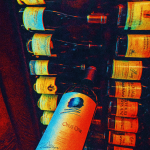Botrytis spores infect grapes only under specific climatic conditions. In California, botrytis is rare because of the relative dryness of the growing season. It needs moisture, ideally near 100 percent humidity at 65 to 75 degrees Fahrenheit, and anywhere from 20 to 35 hours total exposure. The time necessary for infection varies according to temperature, the optimum being approximately 70 degrees Fahrenheit for 30 hours. The first signs of botrytis infection is the appearance of transparent spots on the grape’s surface, about 72 hours after infection. It takes approximately two weeks for botrytis to take its full course; that is, to a level of concentration where most, but not all, the grape’s moisture is lost. During these two weeks, the grape slowly turns brown, with a grayish tinge, and shrivels up as if a raisin. As the botrytis infection progresses, grayish-brown mold may appear on the fruit’s surface. Once the moist period has initiated a botrytis infection, a moderately warm, dry period is needed to induce the grape’s accelerated moisture loss through evaporation. How It Works Microscopic botrytis spores settle on the grape’s surface and send down a mycelium tube into the grape. This tube initiates an enzymatic reaction within the grape that breaks down the cell structure, releasing water, which evaporates into the atmosphere. Naturally, there is more than one spore on the grape, so by the time botrytis cinerea is fully active, the grape skin is punctured by billions of minute holes. Botrytis also metabolizes some of the acidity within the fruit, so the acid never concentrates as much as the sugar. A very slight concentration may occur, nicely balancing the cloying sweetness of the botrytised wine with a refreshing acidity. Botrytis gives grape juice a rich, honeyed, spicy flavor and an aroma that can develop considerable depth and complexity with bottle age. These flavors have inspired many California winemakers to search for this elusive mold. |






